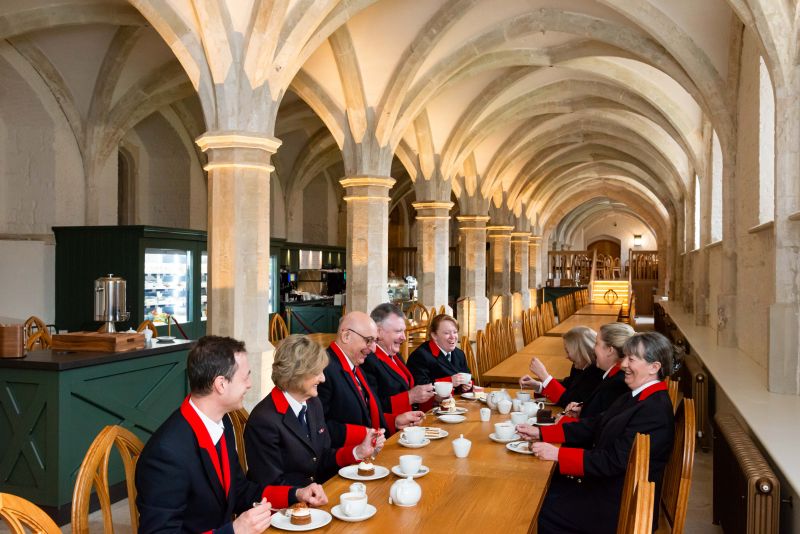
As you sit drinking your coffee in Windsor Castle’s new café in the Undercroft, take a look at the magnificence of where you are. Under St George’s Hall, the Undercroft is one of the oldest surviving parts of the castle. It dates back to the 14th century when King Edward III undertook major restoration work at the castle.
1. During the 1350s and 1360s, Edward III spent the enormous cost of £44,000 (approximately £26m today) on major renovations at the castle. The work took 9 years and was the biggest building project of the entire 14th century.
2. This time is often referred to as the Age of Chivalry and Edward III wanted his castle to reflect this.
3. The dimensions of the Undercroft are some 193 feet (59m) long by 31 feet (9.4m) wide divided into 13 bays (originally 18).
4. Throughout the 14th century, the Undercroft served as the castle’s principal cellar, where barrels of beer and wine were stored on stone or timer butts. Dimly lit with a much lower floor level, the resulting coolness made the vaulted space ideal for this purpose; today wine is still stored under the Undercroft.
5. During the reign of King Charles II, his architect Hugh May divided the Undercroft into several separate rooms and he added windows. To align these externally with those on the floor above, 13 openings were made across the 18 bays of the Undercroft. This gives the room an unusual character, as some of the windows aren’t centrally placed within the bays between the vaulting.
6. The Royal Household expanded at the beginning of the 19th century during the reign of King George IV so additional accommodation and offices were needed at the castle. The architect Sir Jeffry Wyatville further subdivided the Undercroft to make room for the Lord Chamberlain’s Office, the Servants’ Hall and the Yeoman of the Pantry.
7. In 1866, Queen Victoria had two arched openings made in the wall separating the State Entrance and the Undercroft whilst redesigning the Entrance. It is thought that the idea came from Prince Albert who was keen to reveal the 14th-century vaulting in the Undercroft. The Queen’s architect, Anthony Salvin, re-lined the Undercroft in Bath stone adding detailing to harmonise with the mediaeval work.
8. At the time of the 1992 fire in the castle, the Undercroft had been divided into smaller rooms. Afterwards, it was decided to reinstate the Undercroft as a single space in an effort to echo the Undercroft’s at Fountains and Rievaulx Abbeys. The castle’s ground floor had absorbed so much water during the fire that the walls of the Undercroft had to be stripped back to allow them to dry out. It was discovered that much of the room’s early fabric had survived and the subsequent restoration work turned it back into the great mediaeval interior it once was. The beautifully vaulted 14th-century Larderie passage runs alongside the Kitchen Courtyard and is decorated with carved Royal Roses marking its construction by Edward III.
9. Back in 2016, I and other members of the Royal Household had the use of the Undercroft as our ‘green room’ for the pantomime ‘Dick Wittington’ which was performed in front of none other than ‘the Boss’. It was a real privilege to be in there and marvel at the magnificent 14th-century architecture and surrounding rooms including the kitchens and Larderie which also date back to the 14th century.
Related
Comments
Comments are disabled for this post.




 to add an item to your Itinerary basket.
to add an item to your Itinerary basket.















Comment removed by Post Author
Comment removed by Post Author
Comment removed by Post Author
Comment removed by Post Author
Comment removed by Post Author
Comment removed by Post Author
Comment removed by Post Author
Comment removed by Post Author